https://youtu.be/V64iQtqFnzI
I braved the twenty below night temperatures, took 1,159 photos over a four hour period and linked them into a munute long video.

https://youtu.be/V64iQtqFnzI
I braved the twenty below night temperatures, took 1,159 photos over a four hour period and linked them into a munute long video.
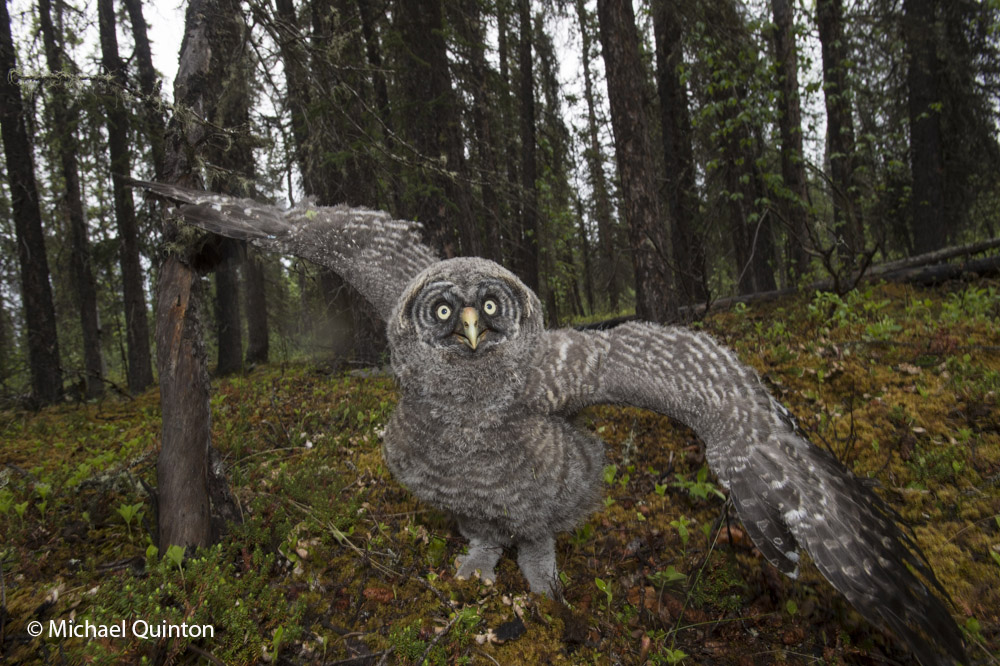 At nearly four weeks a fledged great gray owlet has jumped from its nest to the forest floor. Free from the confines of the nest, (I too am finally freed from the solitary confinement of my photo blind) the owlet walks and leaps to a place to perch.
At nearly four weeks a fledged great gray owlet has jumped from its nest to the forest floor. Free from the confines of the nest, (I too am finally freed from the solitary confinement of my photo blind) the owlet walks and leaps to a place to perch.
Fledged owlets move about fifty to a hundred feet every day, picking out a slanting tree to climb. The ground is a dangerous place for the young, flightless owls. The mobile owl family becomes more difficult to locate by the day.
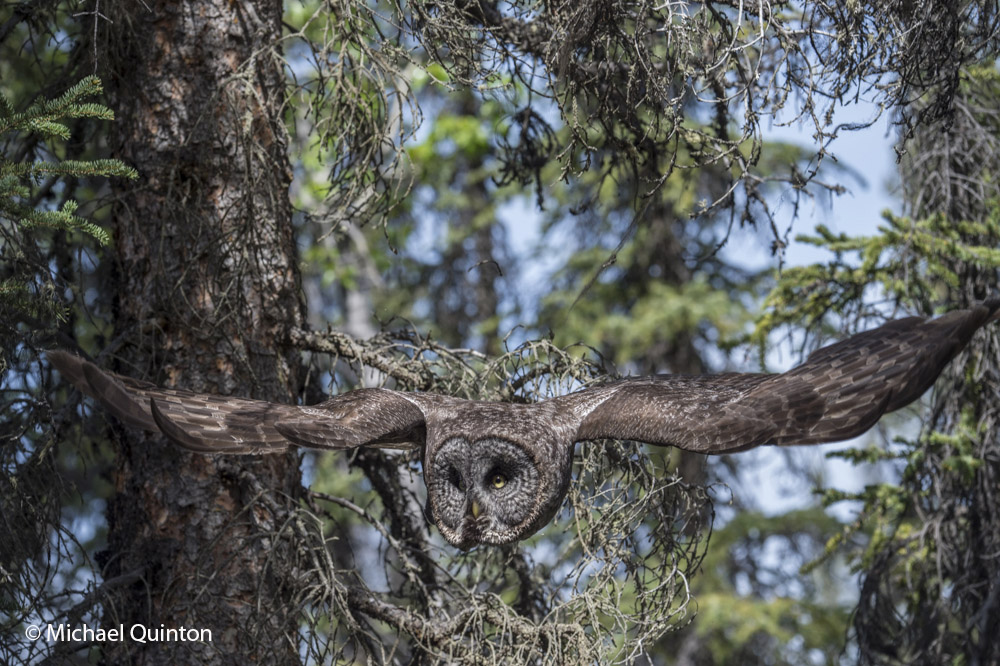 Adults continue to care for their owlets. The female (above), usually staying near the owlets, will do some hunting when an opportunity presents itself.
Adults continue to care for their owlets. The female (above), usually staying near the owlets, will do some hunting when an opportunity presents itself.
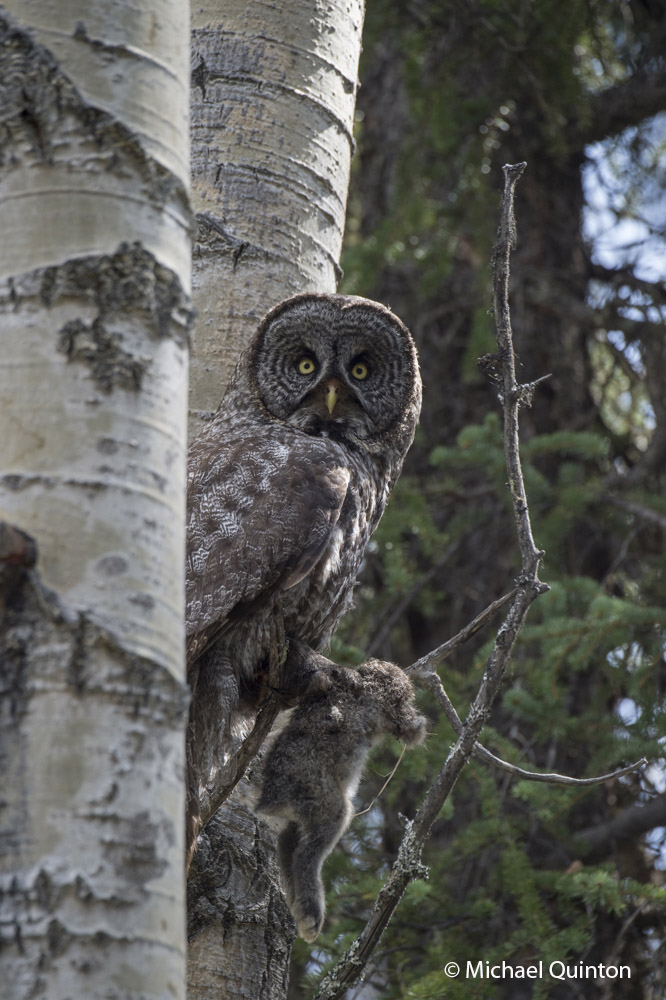 The female with a young snowshoe hare delivered by her mate.
The female with a young snowshoe hare delivered by her mate.
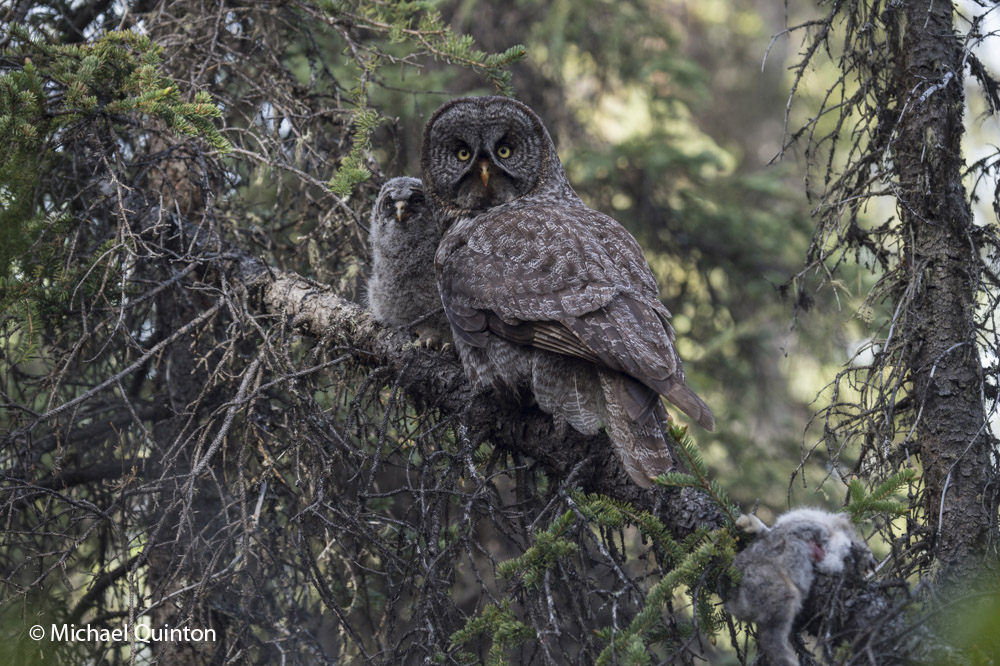 The snowshoe hare, large prey for a great gray owl, will feed her and her owlets for a day. The prey is cached on the ground between feedings.
The snowshoe hare, large prey for a great gray owl, will feed her and her owlets for a day. The prey is cached on the ground between feedings.
 Female perches on log after caching the snowshoe hare.
Female perches on log after caching the snowshoe hare.
Adult female drinking.
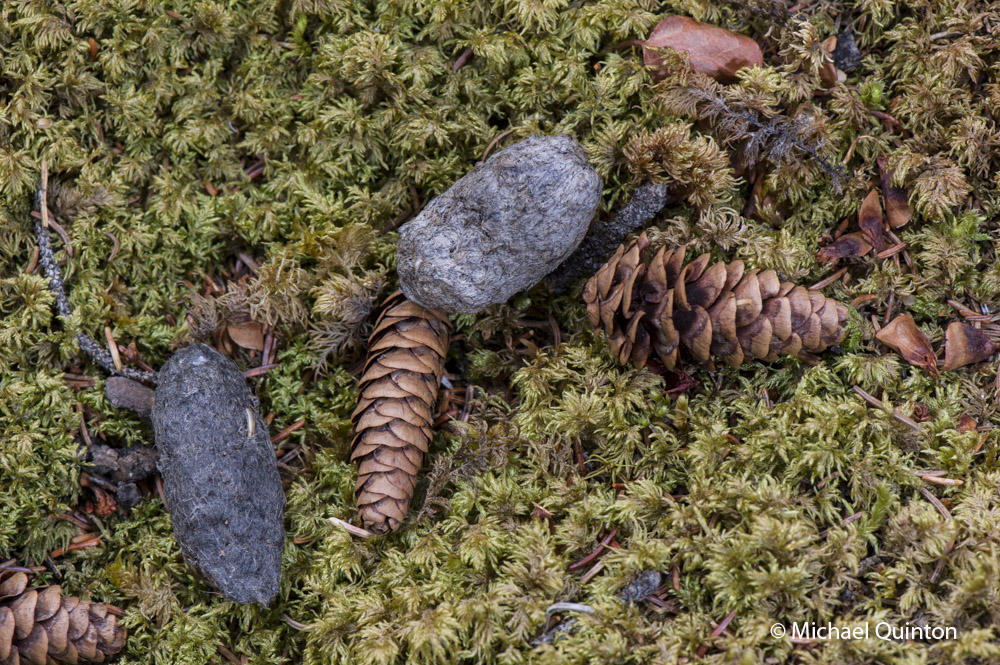 Regurgitated great gray owl pellets and white spruce cones on a bed of sphagnum moss below an owlets perch.
Regurgitated great gray owl pellets and white spruce cones on a bed of sphagnum moss below an owlets perch.
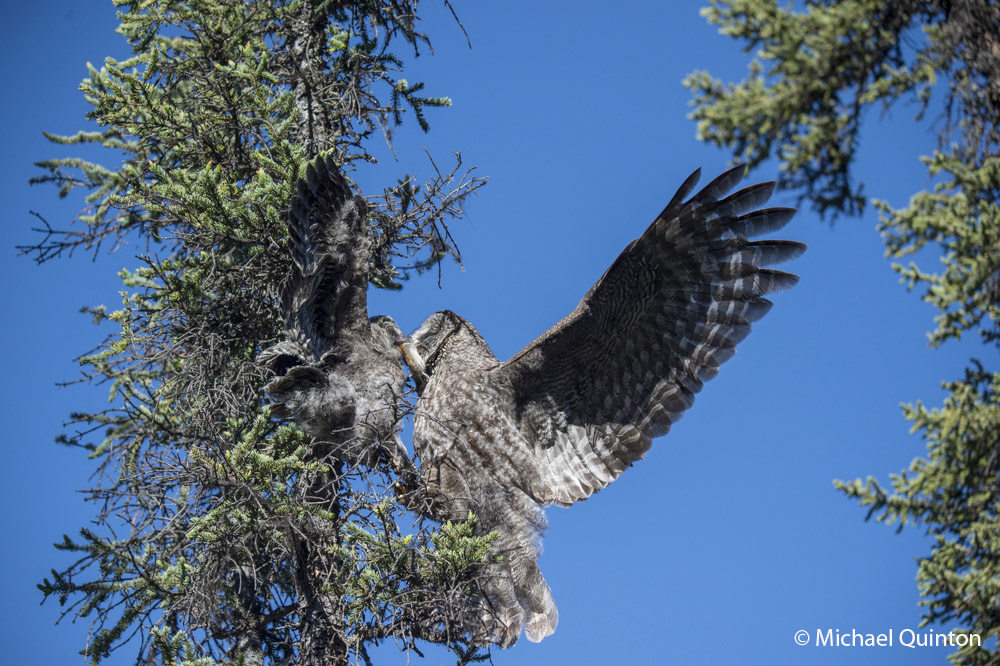 Female delivers her owlet a freshly caught red-backed vole. Fledged owlets swallow voles whole.
Female delivers her owlet a freshly caught red-backed vole. Fledged owlets swallow voles whole.
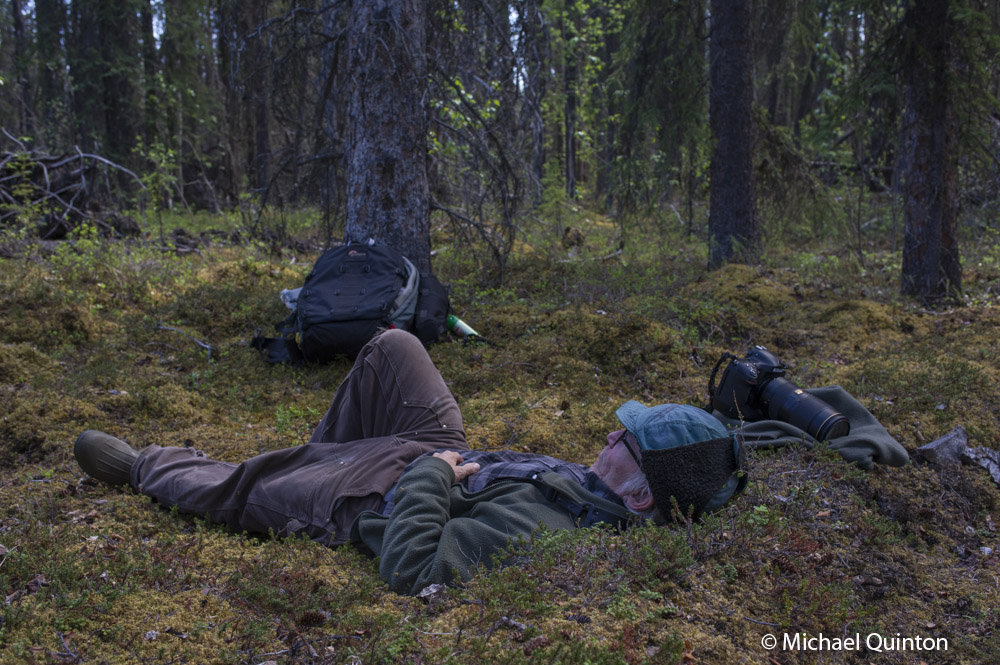 A tough job but it must be done.
A tough job but it must be done.
Female great gray owl holds another red-backed vole just delivered by her mate. The well fed owlets are not hungry at the moment so the vole will be placed in the nest for later. For nearly four weeks I had a rare and intimate view of the owls family life at the nest.
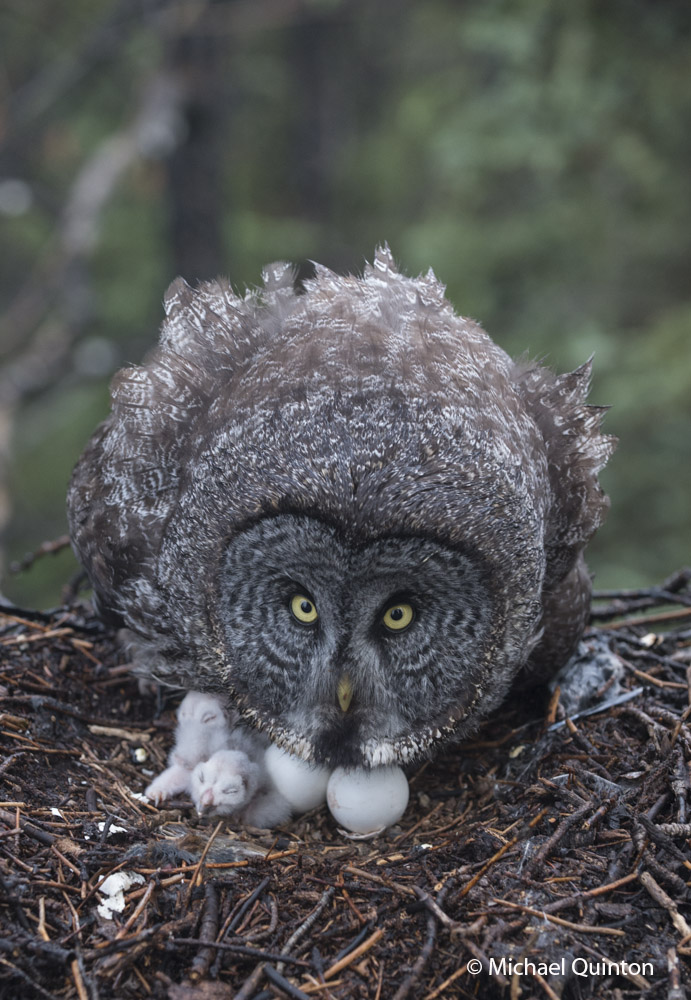 As the female raises up from her brooding, she gives me my first look at the tiny owlets.
As the female raises up from her brooding, she gives me my first look at the tiny owlets.
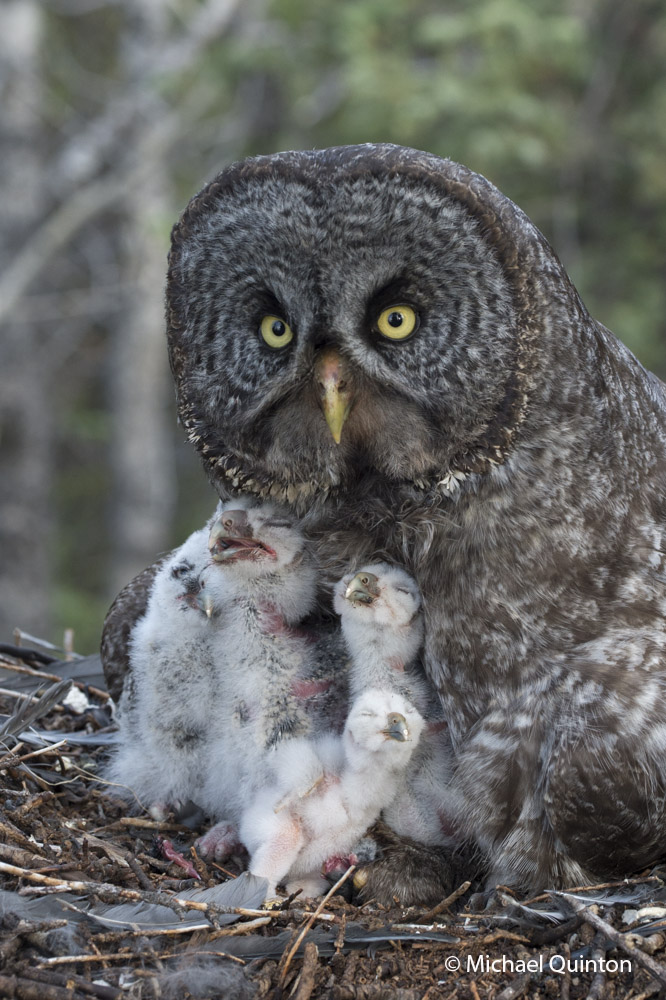 The owlets hatching over a period of about a week account for their age and size difference. Competition among the owls for food favors the older owlets. The smallest owlet, here just a couple of days old, could not hold its own and one morning it was gone.
The owlets hatching over a period of about a week account for their age and size difference. Competition among the owls for food favors the older owlets. The smallest owlet, here just a couple of days old, could not hold its own and one morning it was gone.
https://youtu.be/gG-pWZZjKt4
Watch video of male delivering a red-backed vole. (above)
After a couple of weeks there is no longer a need for constant brooding and the female finally gets a little time to herself. But even then she stays close and alert for danger. One day a pair of ravens hung around the nest in an attempt to harass her from the nest long enough to steal a chick. She held tight and her mate arrived to chase the ravens about. Eventually the ravens left.
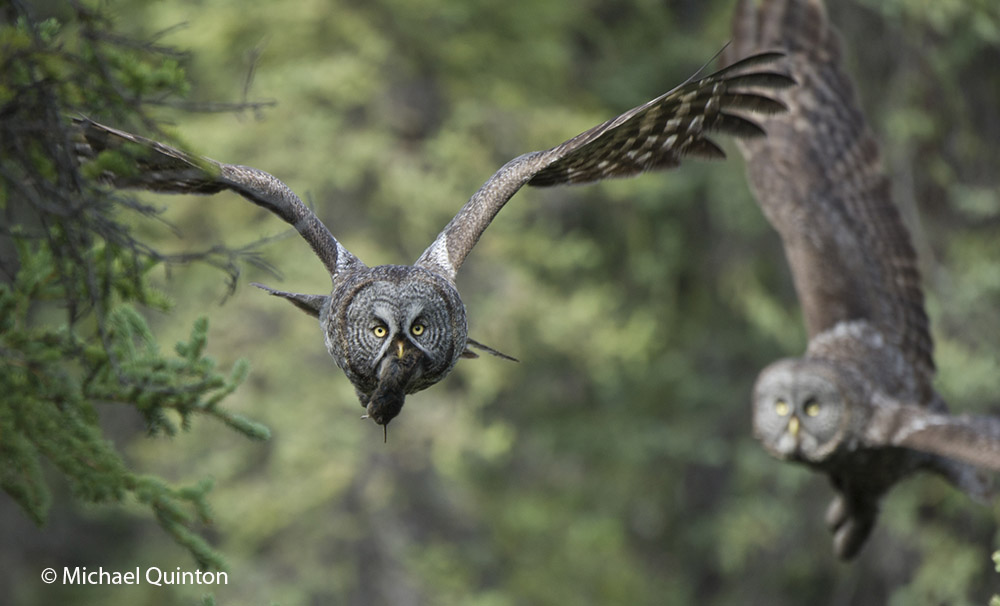 As the female perched near the nest her mate arrives with prey and she follows him in.
As the female perched near the nest her mate arrives with prey and she follows him in.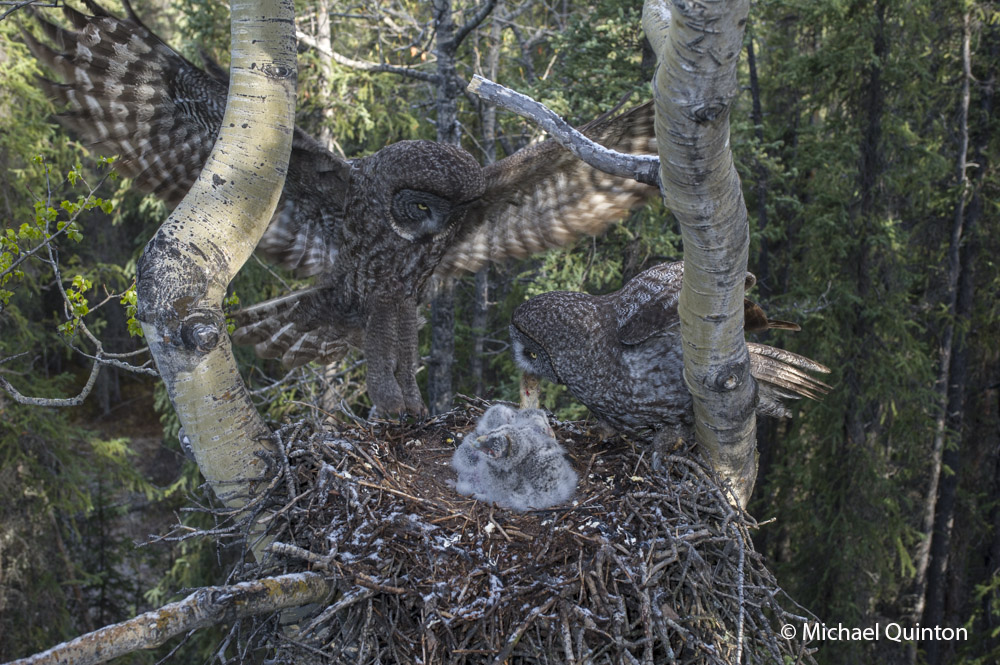
Arriving at the nest the female takes possession of the red-backed vole from her mate. (right) After a brief pause at the nest the male is off again to continue hunting. (below)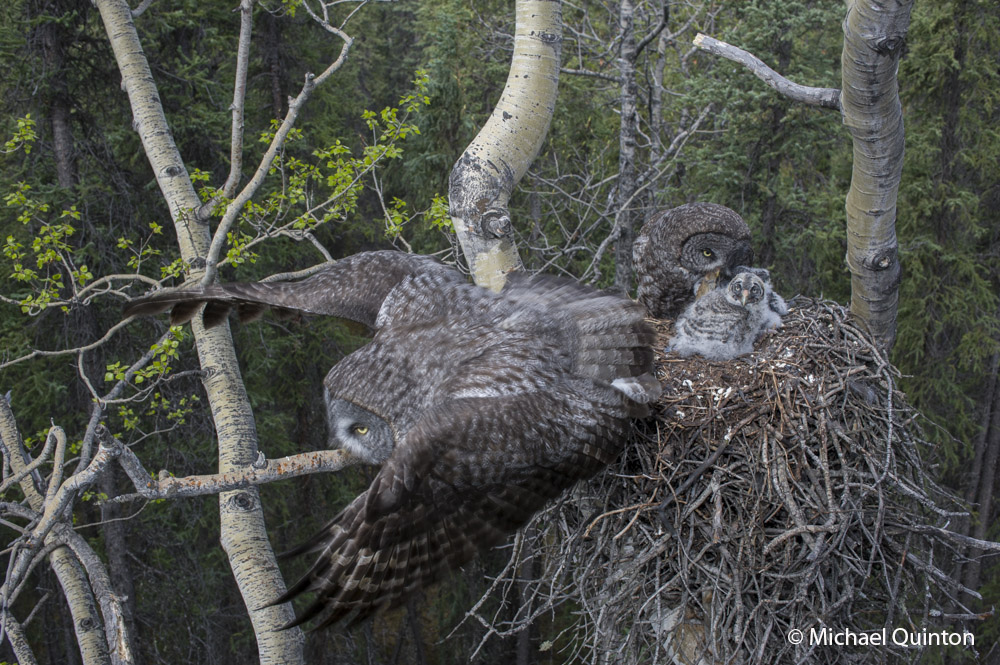
Visit next week for the final post in this series, SECRET LIFE OF A FOREST HUNTER-PART THREE
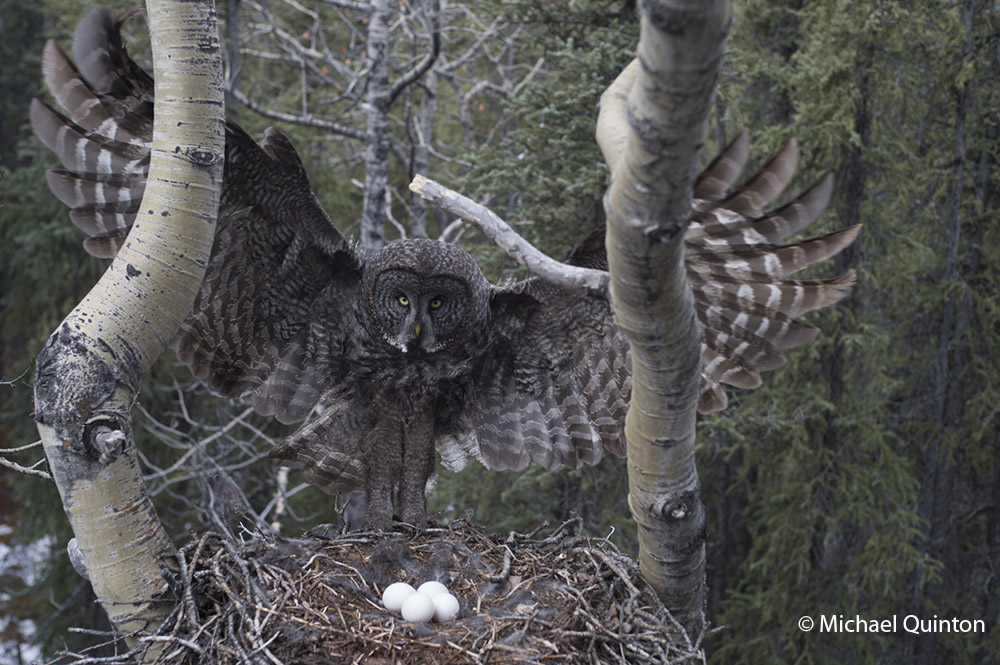 A female great gray owl spreads her wings as she gently lands on the edge of her nest to resume incubating her four eggs. For two months this nest is the nucleus of activity for a pair of great gray owls. Owls do not build their own nests. Instead they use a variety of ready-made and vacant nests, like this one built many years before by northern goshawks. The great grays I had photographed three decades ago in Idaho prefered the bowled out tops of large broken pine trees for their nests.
A female great gray owl spreads her wings as she gently lands on the edge of her nest to resume incubating her four eggs. For two months this nest is the nucleus of activity for a pair of great gray owls. Owls do not build their own nests. Instead they use a variety of ready-made and vacant nests, like this one built many years before by northern goshawks. The great grays I had photographed three decades ago in Idaho prefered the bowled out tops of large broken pine trees for their nests.
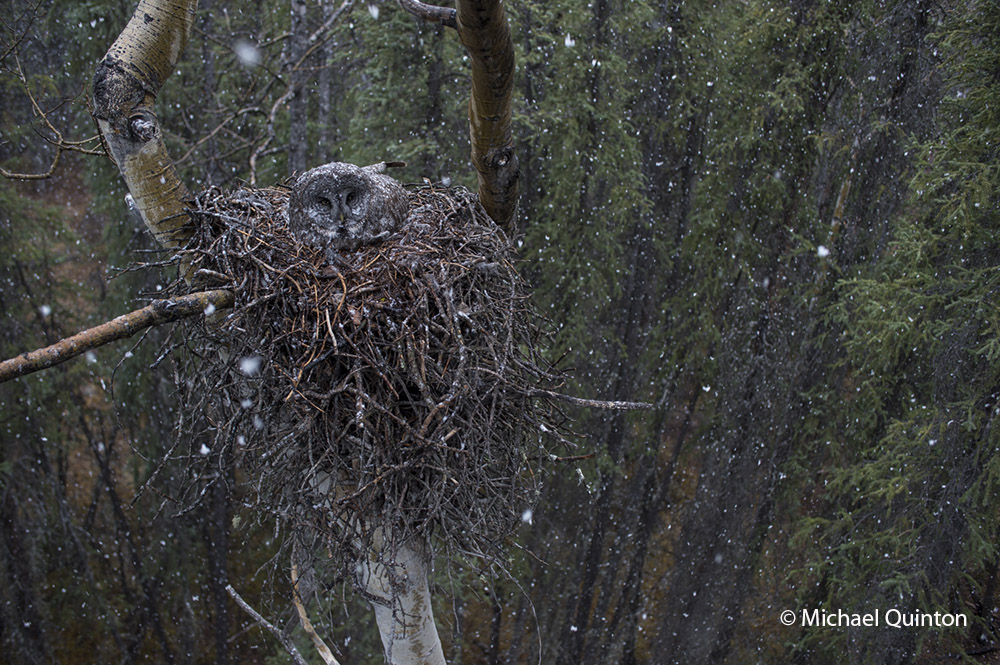 Eggs laid in the third week of April must be protected from the weather, as incubation begins with the first egg. The female does all the incubating and will sit on her eggs for thirty days.
Eggs laid in the third week of April must be protected from the weather, as incubation begins with the first egg. The female does all the incubating and will sit on her eggs for thirty days.
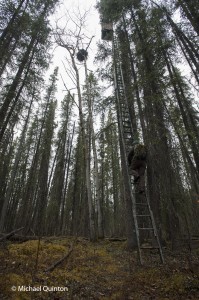 To gain access to the nesting great grays, more than fifty feet above the forest floor, I scabbed two long extensions ladders together and added an additional extension using two by fours. I had located the nest thirteen years ago. The three-foot wide nest was built by northern goshawks in a towering quaking aspen. Every spring I’d hike to the remote nest site to check its status. Goshawks had used the nest only once during the last thirteen years.
To gain access to the nesting great grays, more than fifty feet above the forest floor, I scabbed two long extensions ladders together and added an additional extension using two by fours. I had located the nest thirteen years ago. The three-foot wide nest was built by northern goshawks in a towering quaking aspen. Every spring I’d hike to the remote nest site to check its status. Goshawks had used the nest only once during the last thirteen years.
From my self-imposed confinement in the lofty, swaying photo blind, I witnessed much more than just the daily activities of the great gray owls. The female owl and I watched red squirrels, that rarely seen red squirrel predator, the marten, groups of migrating caribou, and a variety of bird life. Early one morning, not long after arriving, a huffing grizzly bear sow and yearling cub who had caught my scent quickly moved off beneath the blind. Once a curious cow moose who could hear my camera clicking finally looked up.
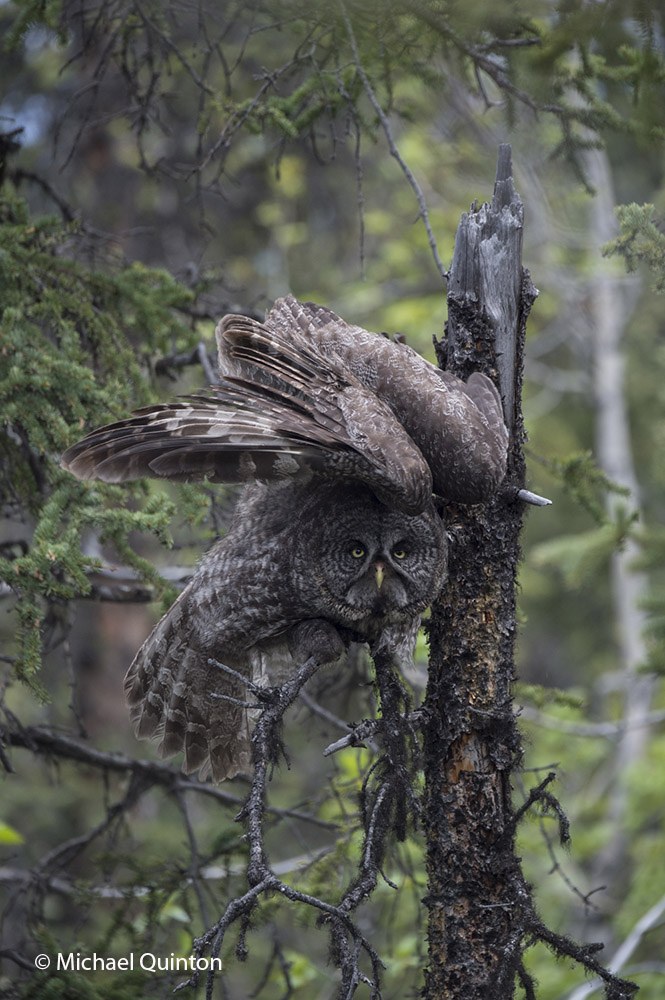 A couple of times a day the female flies off the nest to drink, cast her pellet and perhaps stretch before returning to her precious clutch of eggs.
A couple of times a day the female flies off the nest to drink, cast her pellet and perhaps stretch before returning to her precious clutch of eggs.
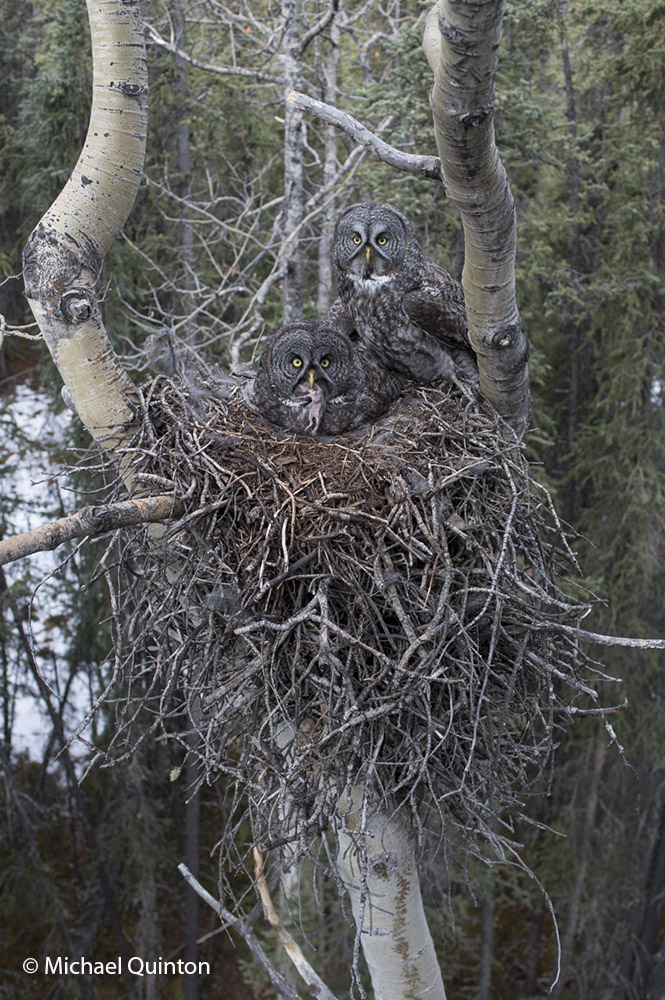 The male hunts for his mate and has just arrived with prey, a baby red squirrel. The male, who hunts during the day using sight and sound, is an opportunist and preys on a variety of small birds and mammals. Red-backed voles are by far the most important prey but shrews, small birds, and young snowshoe hares are also prey. Adult red squirrels are usually too alert and quick to be given much attention by the hunting male. But young squirrels, probably raided from their grass and sphagnum nests, are regularly on the menu.
The male hunts for his mate and has just arrived with prey, a baby red squirrel. The male, who hunts during the day using sight and sound, is an opportunist and preys on a variety of small birds and mammals. Red-backed voles are by far the most important prey but shrews, small birds, and young snowshoe hares are also prey. Adult red squirrels are usually too alert and quick to be given much attention by the hunting male. But young squirrels, probably raided from their grass and sphagnum nests, are regularly on the menu.
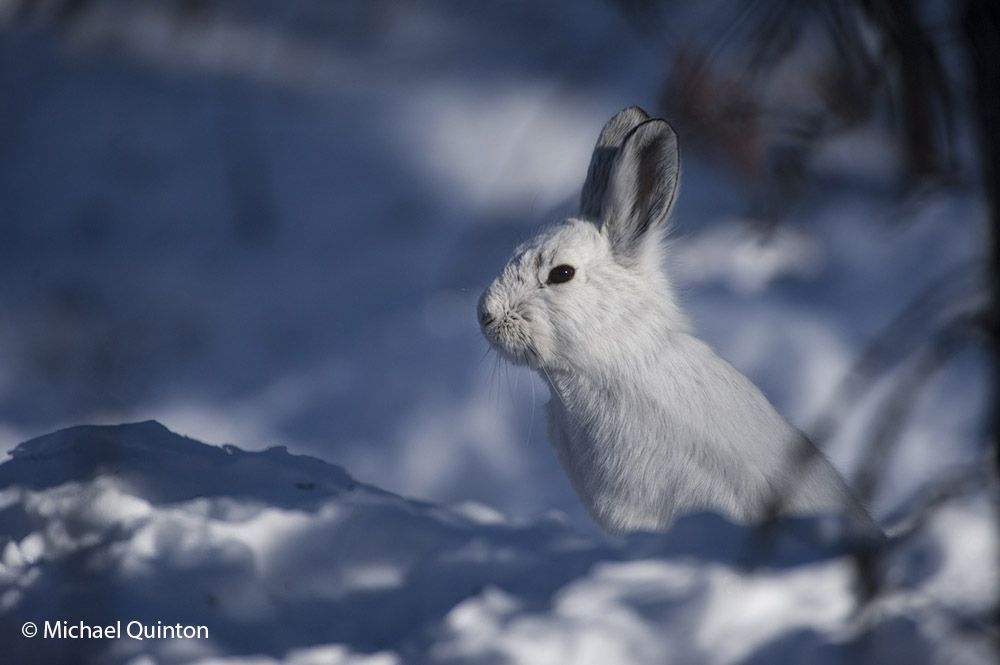 In early March, snowshoe hare (Lepus americanus) tracks began to appear where none had been all winter long. I guess the solitary males are out and about looking for females. The snowshoe hare cycle has been on the upswing for a couple of years but the hares are still uncommon in most of the black spruce forests around our place on the northern edge of Wrangell/St. Elias National Park. High quality hare habitat, mixed forests with willow and alder thickets are the nucleus of hare populations and often the only places where hares are common during low-cycle years . These “bunny patches” are where snowshoe hares multiply and disperse. A rising (or falling) hare population has a big impact on most predators and their prey. With snowshoe hare populations locally low, their main predators, lynx, red fox, northern goshawks, great horned owls and even northern hawk owls are low as well. Low numbers of predators has relieved pressure on prey species such as spruce grouse and snowshoes allowing them to recover. Grouse populations have the ability to rebound rather quickly as we have seen them do locally. All these cycles are driven to a large degree by the rise and fall of snowshoe hares. Continue reading
In early March, snowshoe hare (Lepus americanus) tracks began to appear where none had been all winter long. I guess the solitary males are out and about looking for females. The snowshoe hare cycle has been on the upswing for a couple of years but the hares are still uncommon in most of the black spruce forests around our place on the northern edge of Wrangell/St. Elias National Park. High quality hare habitat, mixed forests with willow and alder thickets are the nucleus of hare populations and often the only places where hares are common during low-cycle years . These “bunny patches” are where snowshoe hares multiply and disperse. A rising (or falling) hare population has a big impact on most predators and their prey. With snowshoe hare populations locally low, their main predators, lynx, red fox, northern goshawks, great horned owls and even northern hawk owls are low as well. Low numbers of predators has relieved pressure on prey species such as spruce grouse and snowshoes allowing them to recover. Grouse populations have the ability to rebound rather quickly as we have seen them do locally. All these cycles are driven to a large degree by the rise and fall of snowshoe hares. Continue reading
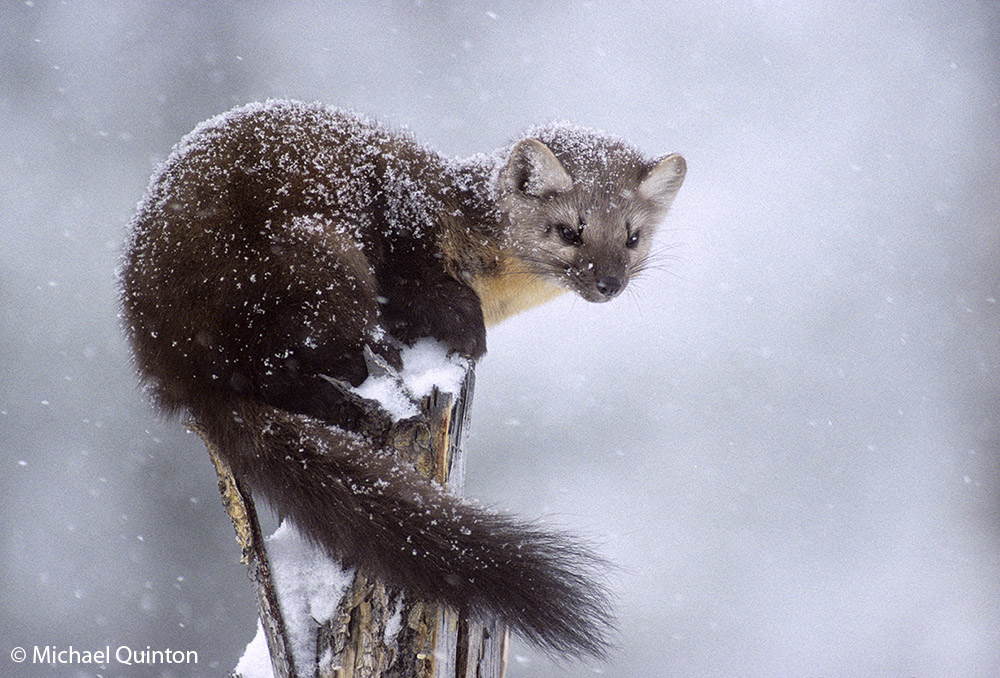 The marten scrapes out a tough living in the northern forests. The largely nocturnal members of the weasel family, prey on small birds and mammals.
The marten scrapes out a tough living in the northern forests. The largely nocturnal members of the weasel family, prey on small birds and mammals.
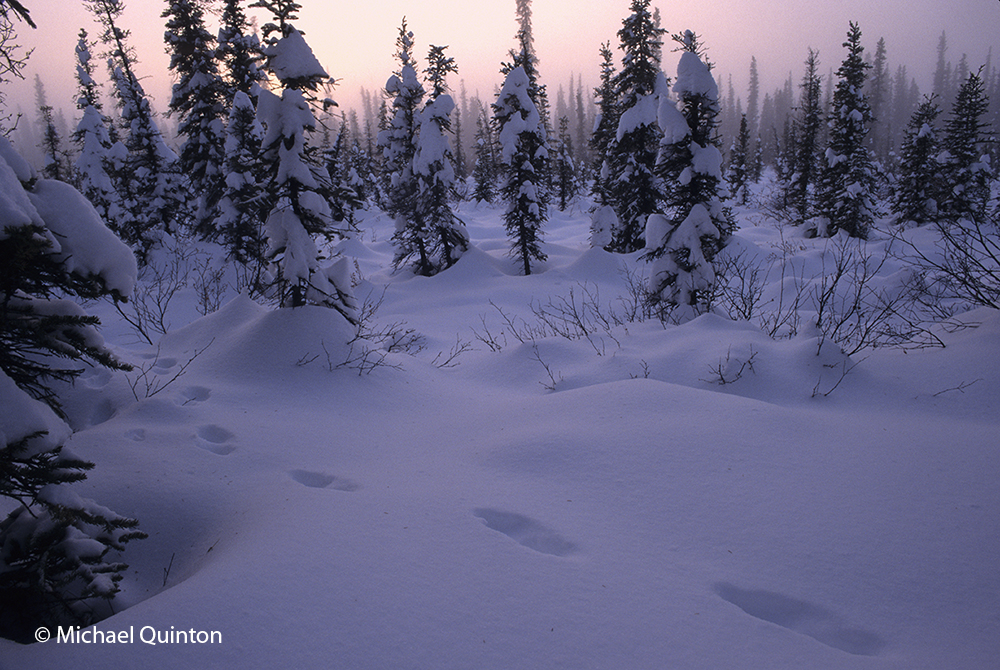 A tireless traveler, the marten (Martes americana) leaves an endless line of tracks through the Alaskan wilderness. Like other members of the weasel family, martens successfully hunt quick prey like the red squirrel and snowshoe hare in deep snow. Tracks are the most common sign of the presence of martens. Following or backtracking marten tracks will tell a story of what this tough, little predator has been up to and gives clues to their habits. Though they are seldom very common, martens are not endangered over most of their range. But martens are so shy and secretive that little is known about their mysterious lives. Old growth forests with large trees and numerous standing and fallen dead trees are a martens prefered habitat, providing cover, food, shelter and cavities for their dens. Continue reading
A tireless traveler, the marten (Martes americana) leaves an endless line of tracks through the Alaskan wilderness. Like other members of the weasel family, martens successfully hunt quick prey like the red squirrel and snowshoe hare in deep snow. Tracks are the most common sign of the presence of martens. Following or backtracking marten tracks will tell a story of what this tough, little predator has been up to and gives clues to their habits. Though they are seldom very common, martens are not endangered over most of their range. But martens are so shy and secretive that little is known about their mysterious lives. Old growth forests with large trees and numerous standing and fallen dead trees are a martens prefered habitat, providing cover, food, shelter and cavities for their dens. Continue reading
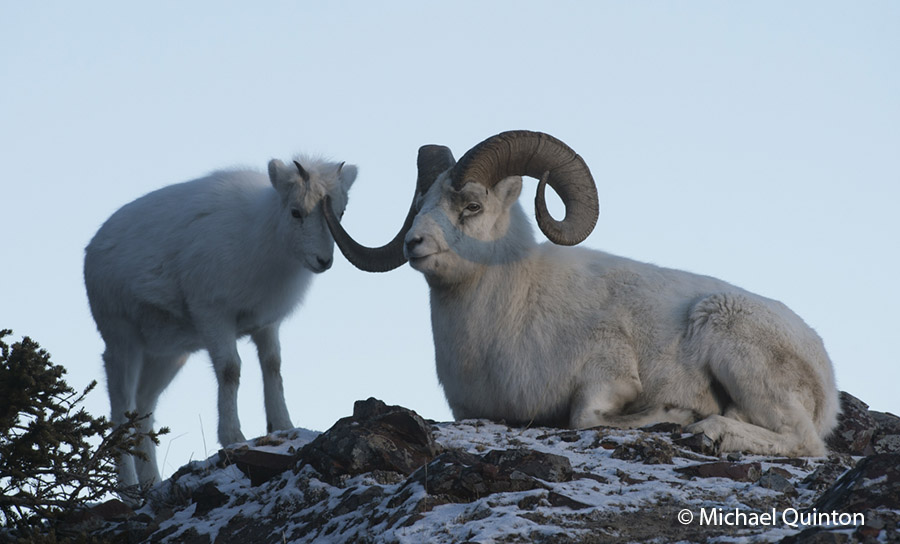 “Some day I’m going to be king of this mountain.”
“Some day I’m going to be king of this mountain.”
Once again I have made the trek into the sheep hills to photograph the majestic dall sheep. Its getting tougher, the mountains bigger, but fear if I ever quite, I’ll probably just keel over.
As I struggled up the mountainside towards the distant white dots, I paused on the edge of a deep canyon to catch my breath. From across the canyon and out of the deep green of the spruce forest came a shrill screaming. Sounding like the death scream of a snowshoe hare, just not quite. I had an idea what was making that sound. An hour later I stood among a group of ewes and lambs. Suddenly the whole herd spooked. They dashed to a ridge top and stared back down. Continue reading
Pink salmon show up in estuaries in early July by the millions. Pink salmon are Alaska’ most common salmon species. They also have the shortest life cycle than other salmon species. Pinks return to freshwater to spawn when they are two years old and immediately begin to change from silver to green and dark gray. And, males form hooked jaws and humped backs. Continue reading
A female northern flicker approaches the nesting cavity.
Life at the nest of northern flickers is at a frantic level. Most of the long, Alaskan summer days keeps the adults working at a breathless pace. The pair at this nest take turns guarding the nest from the resident red squirrel or trespassing northern flickers and taking forays out into the black spruce forest to hunt for their main food, wood ants and their larva. When the female arrives back at the nest cavity with food for the young, the male departs.
To listen to the audio clip, click on left side of the bar. Volume at right. Adult male northern flicker responds to his mate appearing near the nest. Then listen as female enters nesting cavity to feed chicks. Continue reading
 A ruffed grouse male moves slowly through thick cover as it feeds on buds, last years berries and new leaves.
A ruffed grouse male moves slowly through thick cover as it feeds on buds, last years berries and new leaves.
Interior Alaska is definitely spruce grouse country. But along creeks and river bottoms, in old burns, in fact almost anywhere where several species of trees grow in thickets, narrow veins of ruffed grouse habitat can be found. Along the Slana River not far from where it enters the still modest Copper River, aspen, poplar, birch, white and black spruce, alder and a jumble of willow species form thickets where the cryptic ruffed grouse lives. Rose and high bush cranberry in the understory provide year round food for the few grouse that survive there. Continue reading